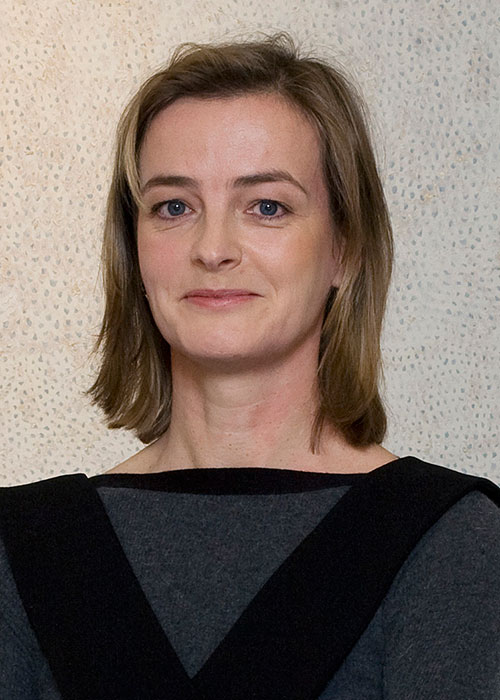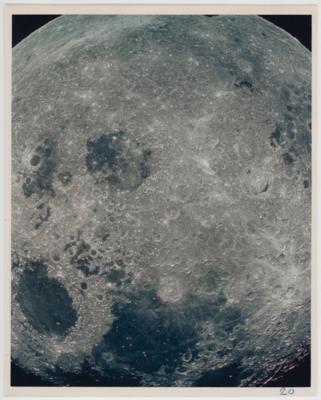William Anders (Apollo 8)
Fantastic view over the near full Moon after the first transEarth injection performed by humans, 21-27 December 1968
Vintage chromogenic print on fiber-based paper, printed 1968, (NASA AS8-14-2485), with"A KODAK PAPER" watermark on verso, 20,3 x 25,4 cm
On December 25, 1968, after completing 10 revolutions around the Moon, Apollo 8's SPS (Service Propulsion System) engine was successfully ignited over the farside to initiate trans-Earth insertion (TEI) and accelerate the spacecraft out of lunar orbit. An engine failure would have left the crew stranded in lunar orbit with no possibility of rescue. Fortunately, everything went smoothly, much to the relief of the crew.
“Once that rocket worked and got us to lunar orbit, then it had to work again, or we were stuck.”
William Anders (Chaikin, Voices, p. 42)
During their 20 hours in lunar orbit, the crew captured photographs of the desolate lunar surface from an altitude of approximately 60 nautical miles. However, due to their arrival in the Moon's shadow, it was only at the beginning of their journey back to Earth that they were presented with unprecedented views of the Moon's sphere in an orientation not observable from Earth. As the spacecraft was gaining altitude following trans Earth ignition, they witnessed the incredible view of the receding Moon and utilized various camera magazines, including one that contained this remarkable photograph of the nearly full Moon taken with a 250mm telephoto lens, showing features of both the lunar nearside and farside.
The eastern portion (top) contains features which were unknown until recently before the mission and were still unnamed. In the western portion (bottom), the Sea of Crises and just right of it the Sea of Tranquility predominate. Near the center the smaller Border Sea and Smyth’s Sea are in sharp contrast to the surrounding terrain. (from NASA SP-246, p. 3)
From the mission transcript after acquisition of signal with Earth following the successful trans Earth ignition over the lunar farside:
089:34:16 Lovell: Houston, Apollo 8, over.
089:34:19 Mattingly (Mission Control): Hello, Apollo 8. Loud and clear.
089:34:25 Lovell: Roger. Please be informed there is a Santa Claus.
089:34:31 Mattingly: That's affirmative. You're the best ones to know.
089:34:37 Lovell: And burn status report: it burned on time; Burn time, 2 minutes, 23 seconds; seven-tenths plus VGX. Attitude nominal, residuals; minus five-tenths VGX, plus four-tenths VGY, minus 0 VGZ; Delta-VC, minus 26.4.
089:35:14 Mattingly: Roger.
089:35:19 Mattingly: Apollo Flight has...
089:35:23 Mattingly: Apollo 8, reconfirm your burn time, please.
089:35:30 Lovell: Roger. We had 2 minutes, 23 seconds. Our - wait one. Stand corrected to that; 3 minutes, 23 seconds.
089:35:43 Mattingly: Thank you. [Long pause.]
This is Mission Control, Houston. Flight Dynamics Officer says that burn is good.
089:36:33 Borman: You get the sensation that you're climbing, Ken.
089:36:35 Mattingly: Say again, Apollo 8.
089:36:41 Borman: I say, this gives you the sensation that you're climbing.
089:36:47 Mattingly: Rog.
Expertin: Mag. Eva Königseder
 Mag. Eva Königseder
Mag. Eva Königseder
+43-1-515 60-421
eva.koenigseder@dorotheum.at
27.09.2023 - 15:13
- Erzielter Preis: **
-
EUR 780,-
- Schätzwert:
-
EUR 800,- bis EUR 1.200,-
- Startpreis:
-
EUR 100,-
William Anders (Apollo 8)
Fantastic view over the near full Moon after the first transEarth injection performed by humans, 21-27 December 1968
Vintage chromogenic print on fiber-based paper, printed 1968, (NASA AS8-14-2485), with"A KODAK PAPER" watermark on verso, 20,3 x 25,4 cm
On December 25, 1968, after completing 10 revolutions around the Moon, Apollo 8's SPS (Service Propulsion System) engine was successfully ignited over the farside to initiate trans-Earth insertion (TEI) and accelerate the spacecraft out of lunar orbit. An engine failure would have left the crew stranded in lunar orbit with no possibility of rescue. Fortunately, everything went smoothly, much to the relief of the crew.
“Once that rocket worked and got us to lunar orbit, then it had to work again, or we were stuck.”
William Anders (Chaikin, Voices, p. 42)
During their 20 hours in lunar orbit, the crew captured photographs of the desolate lunar surface from an altitude of approximately 60 nautical miles. However, due to their arrival in the Moon's shadow, it was only at the beginning of their journey back to Earth that they were presented with unprecedented views of the Moon's sphere in an orientation not observable from Earth. As the spacecraft was gaining altitude following trans Earth ignition, they witnessed the incredible view of the receding Moon and utilized various camera magazines, including one that contained this remarkable photograph of the nearly full Moon taken with a 250mm telephoto lens, showing features of both the lunar nearside and farside.
The eastern portion (top) contains features which were unknown until recently before the mission and were still unnamed. In the western portion (bottom), the Sea of Crises and just right of it the Sea of Tranquility predominate. Near the center the smaller Border Sea and Smyth’s Sea are in sharp contrast to the surrounding terrain. (from NASA SP-246, p. 3)
From the mission transcript after acquisition of signal with Earth following the successful trans Earth ignition over the lunar farside:
089:34:16 Lovell: Houston, Apollo 8, over.
089:34:19 Mattingly (Mission Control): Hello, Apollo 8. Loud and clear.
089:34:25 Lovell: Roger. Please be informed there is a Santa Claus.
089:34:31 Mattingly: That's affirmative. You're the best ones to know.
089:34:37 Lovell: And burn status report: it burned on time; Burn time, 2 minutes, 23 seconds; seven-tenths plus VGX. Attitude nominal, residuals; minus five-tenths VGX, plus four-tenths VGY, minus 0 VGZ; Delta-VC, minus 26.4.
089:35:14 Mattingly: Roger.
089:35:19 Mattingly: Apollo Flight has...
089:35:23 Mattingly: Apollo 8, reconfirm your burn time, please.
089:35:30 Lovell: Roger. We had 2 minutes, 23 seconds. Our - wait one. Stand corrected to that; 3 minutes, 23 seconds.
089:35:43 Mattingly: Thank you. [Long pause.]
This is Mission Control, Houston. Flight Dynamics Officer says that burn is good.
089:36:33 Borman: You get the sensation that you're climbing, Ken.
089:36:35 Mattingly: Say again, Apollo 8.
089:36:41 Borman: I say, this gives you the sensation that you're climbing.
089:36:47 Mattingly: Rog.
Expertin: Mag. Eva Königseder
 Mag. Eva Königseder
Mag. Eva Königseder
+43-1-515 60-421
eva.koenigseder@dorotheum.at
|
Käufer Hotline
Mo.-Fr.: 10.00 - 17.00
kundendienst@dorotheum.at +43 1 515 60 200 |
| Auktion: | The Beauty of Space - Iconic Photographs of Early NASA Missions |
| Auktionstyp: | Online Auction |
| Datum: | 27.09.2023 - 15:13 |
| Auktionsort: | Wien | Palais Dorotheum |
| Besichtigung: | Online |
** Kaufpreis inkl. Käufergebühr und Mehrwertsteuer
Es können keine Kaufaufträge über Internet mehr abgegeben werden. Die Auktion befindet sich in Vorbereitung bzw. wurde bereits durchgeführt.

